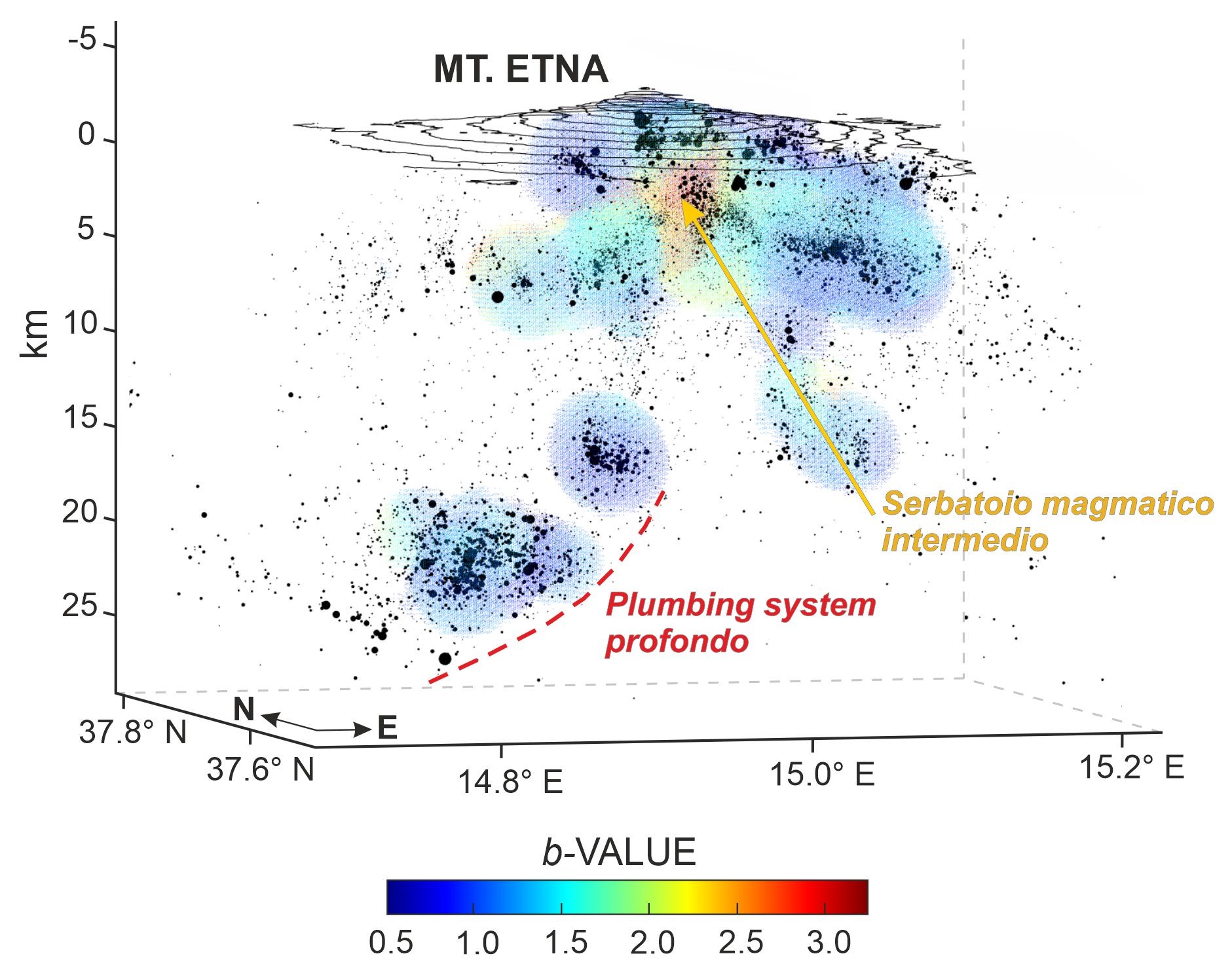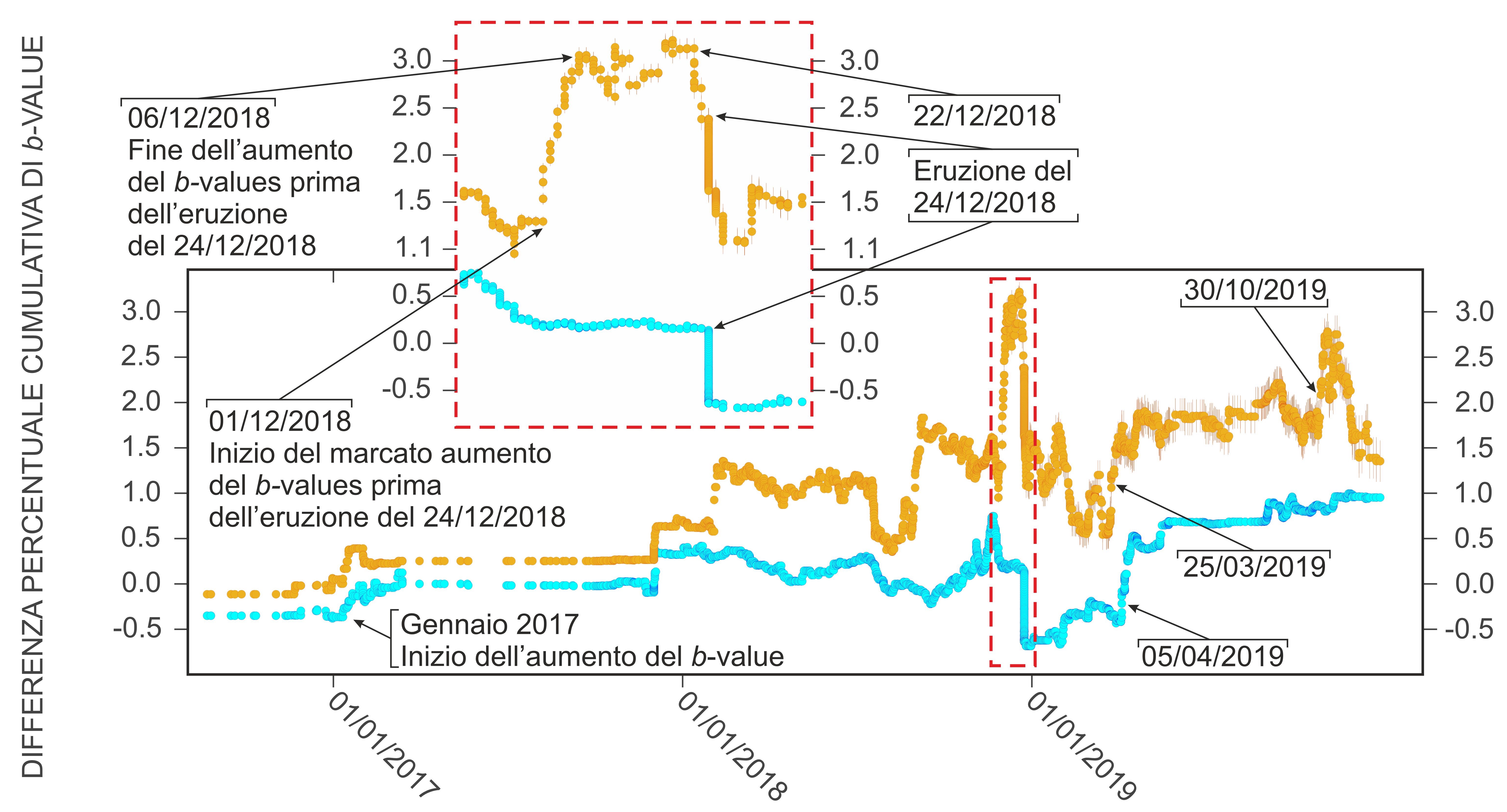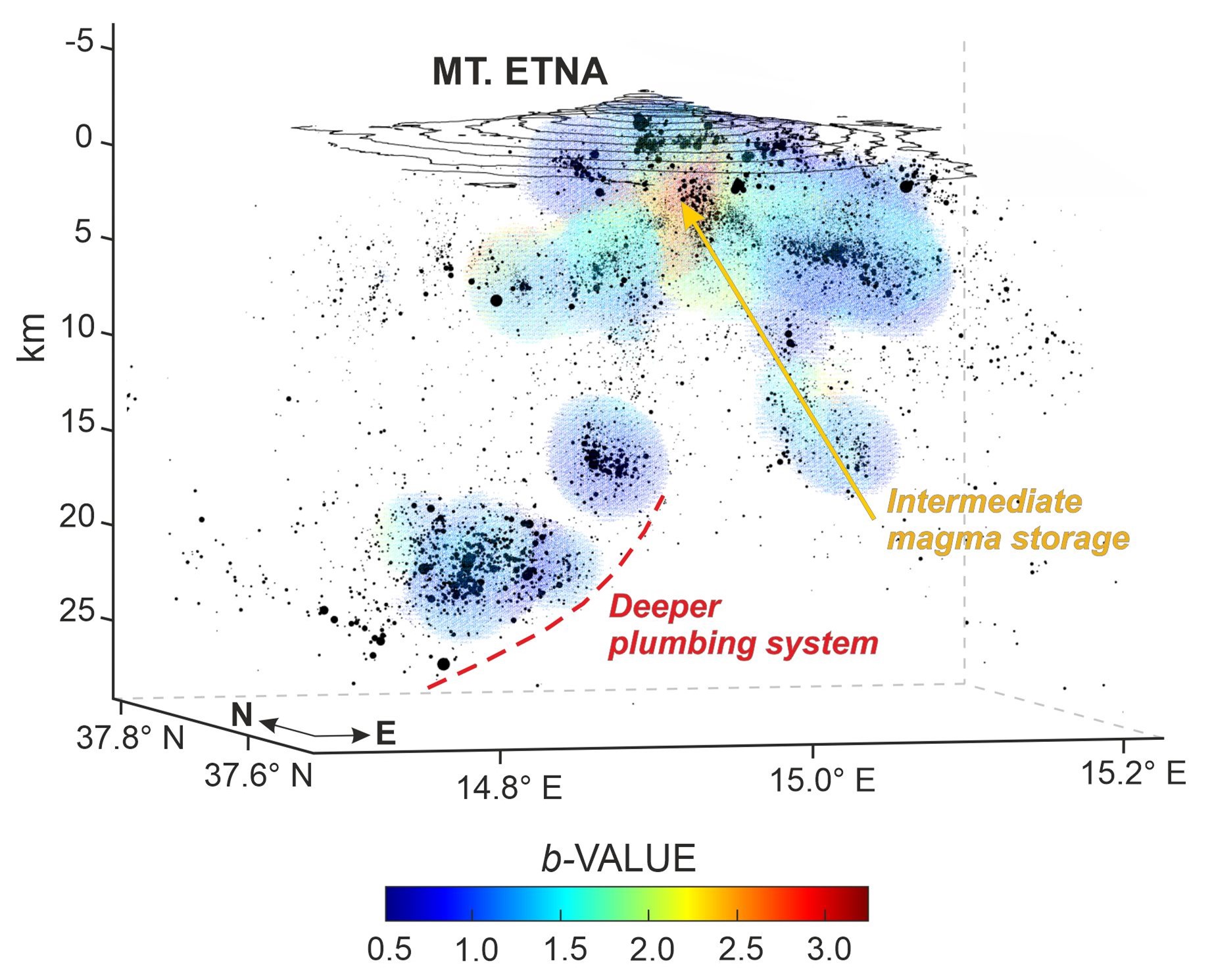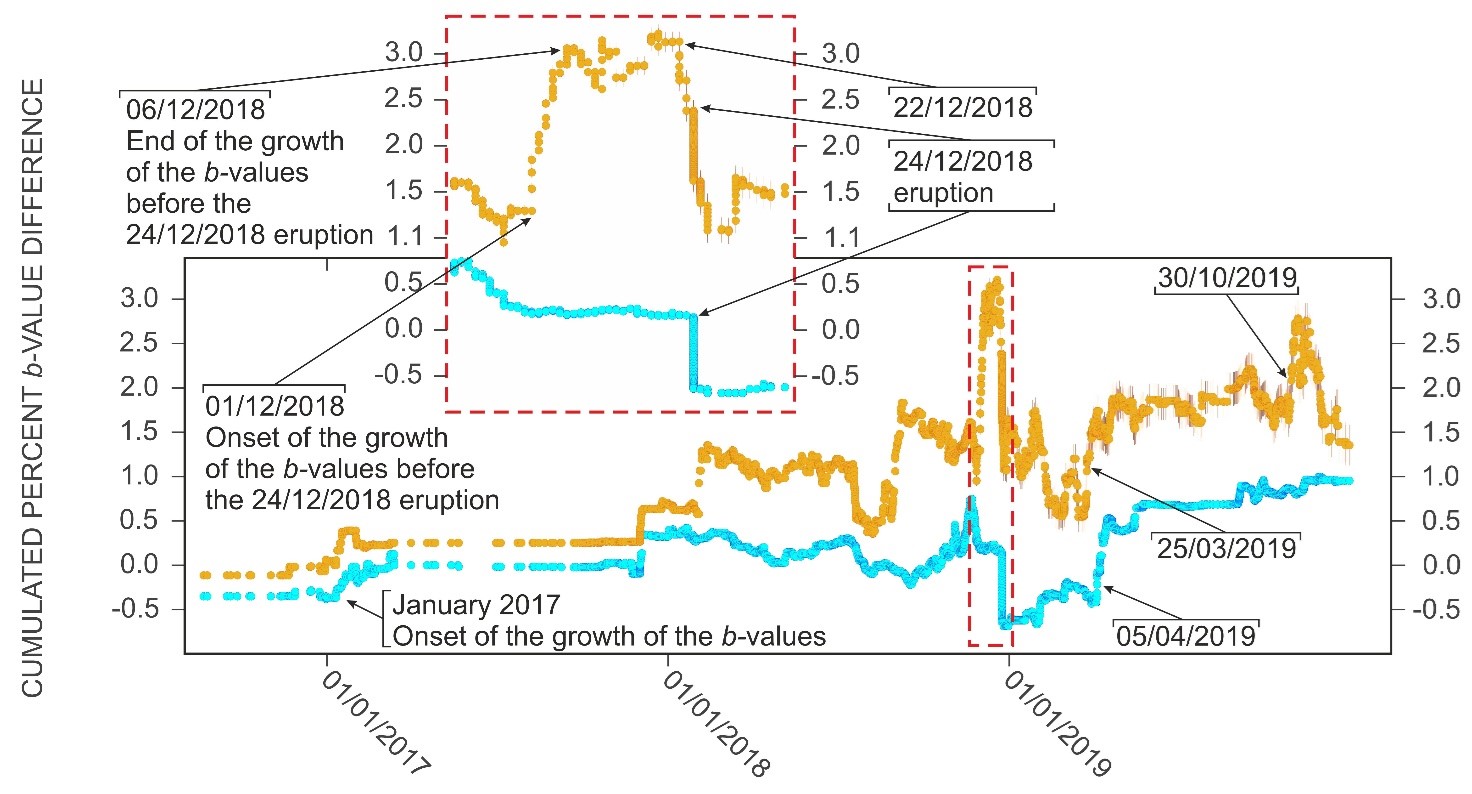Analizzare la sismicità naturale dell’Etna per indagare la risalita dei fluidi magmatici lungo il “plumbing system” del vulcano, ovvero lungo quel settore della crosta terrestre attraverso cui il magma viene trasferito dalle profondità della sorgente magmatica fino alla superficie. È questo il focus principale dello studio condotto da un team di ricercatori dell’Istituto Nazionale di Geofisica e Vulcanologia (INGV) e appena pubblicato sulla rivista scientifica ‘Communications Earth & Environment’ di Nature.
Analizzando più di 13.700 terremoti avvenuti tra il 2005 e il 2019, registrati dalle oltre 30 stazioni sismiche della rete di monitoraggio dell’Osservatorio Etneo dell’INGV, i ricercatori hanno evidenziato come l’analisi della sismicità naturale possa essere utilizzata per indagare la risalita del magma, nonché per studiare la struttura della crosta al di sotto dell’Etna.
“Il settore crostale che ospita l’Etna è caratterizzato da un’elevata sismicità, con numerosi terremoti legati a processi di fratturazione e a movimenti lungo piani di faglia pre-esistenti. Tali eventi sismici possono essere innescati sia dalla spinta del magma in risalita, sia dai processi tettonici di deformazione della crosta terrestre”, spiega Marco Firetto Carlino, ricercatore dell’INGV e autore dello studio. “Tuttavia, le locali condizioni di stress (come, ad esempio, la pressione esercitata dal magma), l’azione dei gas magmatici presenti nel sottosuolo, i gradienti termici e le proprietà meccaniche dei diversi volumi crostali in grado di generare terremoti condizionano le modalità con cui l’energia sismica viene rilasciata. In particolare, studiando il rapporto tra il numero di terremoti che avvengono in una determinata regione e la relativa magnitudo, attraverso un parametro noto come ‘b-value’, è possibile definire se tale regione tende a rilasciare energia sismica preferenzialmente attraverso numerosi terremoti di relativa bassa magnitudo, oppure attraverso meno frequenti eventi di maggiore energia”.
Questo studio ha permesso ai ricercatori di individuare una zona asismica che si estende da una profondità di oltre 30 km fino a circa 10 km al di sotto dell’intera regione etnea, che corrisponde alla parte più profonda del “plumbing system”. Più in superficie è stato invece identificato un serbatoio magmatico intermedio, localizzato tra 1 e 6 km al di sotto del livello del mare, intorno al quale avvengono numerosi terremoti di bassa magnitudo favoriti dall’elevata pressione dei fluidi magmatici e dalle condizioni di diffusa fratturazione della crosta.
“L’analisi delle variazioni temporali del b-value lungo il ‘plumbing system’ etneo ha permesso di indagare il movimento del magma in profondità”, prosegue Firetto Carlino. “In particolare, il 24 dicembre 2018 l’attività etnea è stata caratterizzata da uno dei maggiori eventi intrusivi mai registrati, ovvero legato alla risalita di circa 30 milioni di metri cubi di magma che hanno arrestato la loro ascesa al di sotto del vulcano, all’incirca al livello del mare, innescando una modesta eruzione durata solo 4 giorni. Le serie temporali mostrano una pressurizzazione nell’intorno del serbatoio intermedio ad opera dei gas magmatici, tracciata da un marcato aumento del b-value, avvenuta circa 19 giorni in anticipo rispetto all’eruzione. Quest’ultima è stata poi anticipata da un crollo del b-value 2 giorni prima dell’evento”.
“L’analisi di questo parametro sismologico ha permesso di ipotizzare che l’anomalo accumulo di magma all’interno del vulcano possa essere stato causato da un aumentato stress lungo il ‘plumbing system’, che può essere ricondotto o a dinamiche intrinseche legate al trasferimento del magma stesso, oppure a deformazioni crostali di origine tettonica. In quest’ultima ipotesi, i processi tettonici sarebbero in grado di produrre localmente deformazioni talmente rapide e intense da inibire temporaneamente il trasferimento di magma fino in superficie”, conclude il ricercatore.
#ingv #nature #etna #eruzione #sismicità #vulcano
---
Etna | Seismicity of the Etna area provides the chance to investigate magma uprising beneath the volcano
The analysis of seismicity in the Etna area allows us to outline the crustal structure through which magma uprises and to investigate the migration of magmatic fluids along the volcano's plumbing system
Analyzing the natural seismicity of Etna to investigate the ascent of magmatic fluids along the “plumbing system” of the volcano, or rather along that sector of the Earth's crust through which magma is transferred from the depths of the magma source to the surface. This is the main focus of the study “ conducted by a team of researchers from the Istituto Nazionale di Geofisica e Vulcanologia (INGV) and just published in the scientific journal ‘Communications Earth & Environment’ by Nature.
By the analysis of more than 13,700 earthquakes that occurred between 2005 and 2019, recorded by the more than 30 seismic stations of the INGV’s Etnean Observatory monitoring network, the researchers highlighted how the analysis of natural seismicity can be used to investigate magma ascent, as well as to study the structure of the crust beneath Etna.
“The crustal sector beneath Mt. Etna is characterized by high seismicity, with numerous earthquakes linked to fracturing processes and slip along pre-existing fault surfaces. Such seismic events can be triggered both by the push of the ascending magma and by tectonic processes deforming Earth’s crust”, explains Marco Firetto Carlino, INGV researcher and author of the study. “However, the local stress conditions (such as, for example, the pressure exerted by the magma), the action of the magmatic gasses in the subsurface, thermal gradients and the mechanical properties of the different crustal volumes capable of generating earthquakes affect the way in which seismic energy is released. In particular, by studying the relationship between the number of earthquakes occurring in a given region and related magnitude, through a parameter known as ‘b-value’, it is possible to define whether this region tends to release seismic energy preferentially through numerous earthquakes of relatively low magnitude, or through less frequent but more energetic events”.
This study allowed the researchers to identify an aseismic area that extends from over 30 to about 10 km of depth below the entire Etna region, which corresponds to the deepest part of the “plumbing system”. At shallower depths, an intermediate magma storage has been identified between 1 and 6 km below sea level, around which many low-magnitude earthquakes occur, favored by the high magmatic gas pressure and by the intense fracturing condition of the crust.
“The analysis of the temporal variations of the b-value along the Etna ‘plumbing system’ made it possible to investigate magma movements in depth”, continues Firetto Carlino. “In particular, on 24 December 2018 Mt. Etna experienced one of the strongest known intrusive episodes, related to the ascent of about 30 million cubic meters of magma that aborted, rather oddly, its ascent inside the volcano at about sea level. Nevertheless, this major intrusive event resulted in a relatively modest eruption that lasted only 4 days. The time series show a pressurization by magmatic gasses around the intermediate storage, marked by a strong increase in the b-value that occurred about 19 days before the eruption. This eruption was then preceded by a drop of the b-value 2 days before the event”.
“The analysis of this seismological parameter has allowed us to speculate that the anomalous accumulation of magma inside the volcano may have been linked to increased stress along the ‘plumbing system’, which can be traced back to magma dynamics or to crustal deformation of tectonic origin. In the latter hypothesis, tectonic processes might locally result in small-scale deformation that can be so rapid and strong as to severely perturb the isostatic uprising of magma within the crust”, concludes the researcher.
#ingv #nature #etna #eruption #volcano #plumbingsystem

Figura 1 - Distribuzione della sismicità (punti neri, la cui dimensione è funzione della magnitudo) e del relativo b-value (punti colorati) nella regione crostale del Monte Etna. Il “plumbing system” profondo del vulcano corrisponde ad una zona pressoché asismica, mentre l’intorno del serbatoio magmatico intermedio è caratterizzato da elevati valori di b-value.

Figura 2 - Serie temporali che mostrano la variazione di b-value nell’intorno del serbatoio magmatico intermedio (in giallo) e nella porzione più superficiale del “plumbing system” (in azzurro). Si nota come i valori di b crescano marcatamente solo nell’intorno del serbatoio magmatico circa 19 giorni prima dell’eruzione del 24/12/2018, a causa di una pressurizzazione del sistema ad opera dei gas magmatici. L’eruzione è anticipata da un crollo del b-value iniziato il 22/12/2018 solo nell’intorno del serbatoio magmatico, e continuato fino al giorno dell’eruzione in entrambe le serie temporali.

Figure 1 – Volumetric view of seismicity (dark dots whose dimension is plotted as a function of magnitude) and related b-values (coloured dots) in the crustal region beneath Mt. Etna. The deeper “plumbing system” is highlighted by an aseismic zone, while the surrounding of the intermediate magma storage is characterized by high b-values.

Figure 2 - Time series showing b-value variations in the surrounding of the intermediate magma storage (yellow) and within the shallower portion of the "plumbing system" (blue). The b-values notably increase only around the magma storage about 19 days before the 24/12/2018 eruption, due to a pressurization of the system by magmatic gases. The eruption was preceded by a fall of the b-value started on 22/12/2018 only in the surrounding of the magma storage, and continued until the day of the eruption in both time series.




